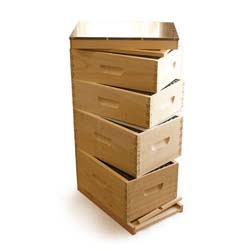Varroa mites, also referred to as their scientific name “Varroa destructor”, are parasites of the European Honeybee (Apis mellifera). They target honeybee colonies specifically because their beehives make a perfect and safe place for them to find food and reproduce. Though Varroa mites weren’t a huge problem for beekeepers in the U.S. until the late 1980s, their numbers have rapidly increased, and their infestations have seriously impacted beekeeping worldwide.
Varroa mites aren’t just an issue because they like to live and reproduce inside beehives; their presence is incredibly harmful to honeybees for a few reasons. First and foremost, they prefer to raise their own young inside cells in a beehive’s brood nest. The cells of developing bees provide mites with a safe, warm space to reproduce. By feeding on the fat and blood of honeybees, especially developing brood, they weaken bees, transmit diseases, and damage bees’ bodies, often causing deformities and impaired immunity. These effects contribute to shortened honeybee lifespans and long-lasting colony issues.

Though it is directly detrimental for adult bees to have mites feeding on their bodies, the diseases that Varroa mites transmit to honeybees are a much bigger cause for concern; Varroa mites are a huge transmitter of many deadly viruses. The viral spread of these diseases and viruses can wipe out entire colonies, even those that were healthy and thriving previously. These viruses don’t just impact individual bees, either, as some can be passed on to future generations of bees, even without direct mite exposure.
(Check out the “Read More” section below for additional resources on the diseases that Varroa may spread, and help with managing them, too.)
Despite being a huge problem, managing Varroa mite concerns is possible… if you have the right knowledge! The first step in managing Varroa is having an “Integrated Pest Management” plan in place, and understanding the reproduction cycle, lifecycle, and health status of your honeybee colony(ies). As you frequently complete hive inspections and take notes about what you’re seeing, carefully monitor not just your bees’ health, but the number of mites present inside the hive, too. If the number of mites reaches a threshold where bees are at risk, there are many chemical and natural treatments available (find more mite testing and treatment resources below) that can help keep varroa mite numbers low.
Because honeybees are such awesome creatures and benefit the world in many ways outside of just in beekeeping (especially through their pollination and biodiversity impacts), understanding and managing varroa mites is integral in supporting not just your own colonies’ health, but in helping future generations of honeybee populations everywhere, too.
Read More
What is the Varroa Destructor Mite?
How Taking Notes Can Help Manage Varroa Mites
Varroa Mites & Honeybee Viruses
Choosing a Treatment For Varroa Mites
The Threat of Varroa Mites: Part 1
The Importance of Timing in Varroa Mite Management
VSH and The Selective Breeding of Bees To Fight Varroa
The Threat of Varroa Mites: Part 2*
*Colony Member-Only Content
